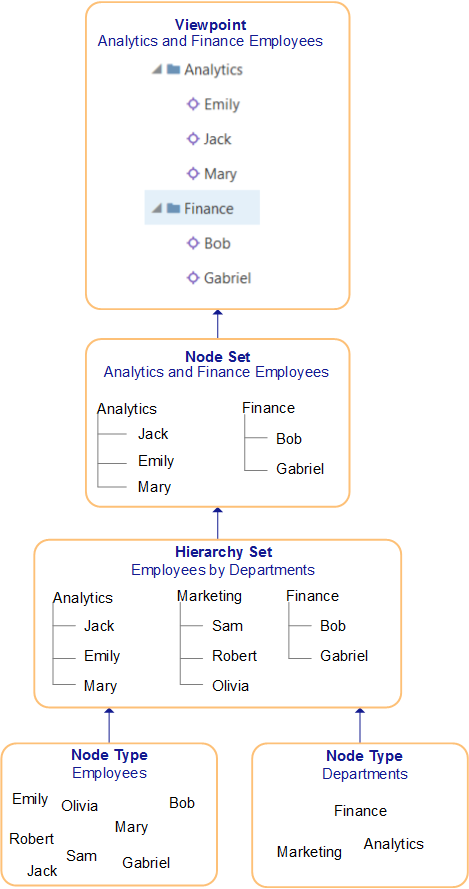20 Working with Data Objects and the Data Chain
The basic organizational structure in Oracle Fusion Cloud Enterprise Data Management is an application, and each application contains dimensions (such as Product and Entity). Each dimension contains a series of related data objects called data chains, which consist of node types, hierarchy sets, node sets, and viewpoints. These data objects are the building blocks of the Cloud EDM solutions you will create.
The way in which a viewpoint and its related data objects are configured determine the nodes available in the viewpoint. In addition, the data chain defines characteristics of the viewpoint such as those in the following list:
- Whether the nodes are a list or a hierarchy
- Rules defining relationships between the hierarchy's nodes
- The nodes' properties
- The actions users can perform
The following table summarizes the data objects. For more information about the data objects, see Understanding Data Chains.
| Data Object | Description |
|---|---|
| Node type | Contains all nodes of a given category. For example, account nodes would be contained by an Accounts node type. See Working with Node Types |
| Hierarchy set | Defines nodes' parent-child relationships. See Working with Hierarchy Sets. |
| Node set | Defines the group of nodes available in a viewpoint. See Working with Node Sets. |
| Viewpoint | Presents the node set to users, and defines actions users can perform and properties users can edit. See Understanding Viewpoints. |
Node types, hierarchy sets, and node sets are reusable objects. For example, if you have a hierarchy that is used in different viewpoints, you typically would use its hierarchy set object in all of those viewpoints.
For more information, see:
Example 20-1 Data Chain for a Hierarchy Example
Suppose that you are working with hierarchies that list employees by departments. The viewpoint contains hierarchies that represent the employees of the Analytics and Finance departments, as shown in the following example:

The application also contains another hierarchy for the Marketing department, but that hierarchy is not included in the viewpoint. The following table describes the data chain upon which this viewpoint is built:
| Data Object | Description |
|---|---|
| Node types | The nodes belong to the following node types:
|
| Hierarchy set | Defines the parent-child relationships as follows:
The hierarchy set also defines the child Employees nodes of the Departments nodes. |
| Node set | Includes the Analytics and Finance departments' hierarchies. The hierarchy set's Marketing hierarchy is excluded. |
| Viewpoint | Displays the nodes specified in the node set. |
The following diagram shows the data chain used to define the viewpoint:

Videos
| Your Goal | Watch This Video |
|---|---|
|
Learn more about data objects and the data chain. |
|